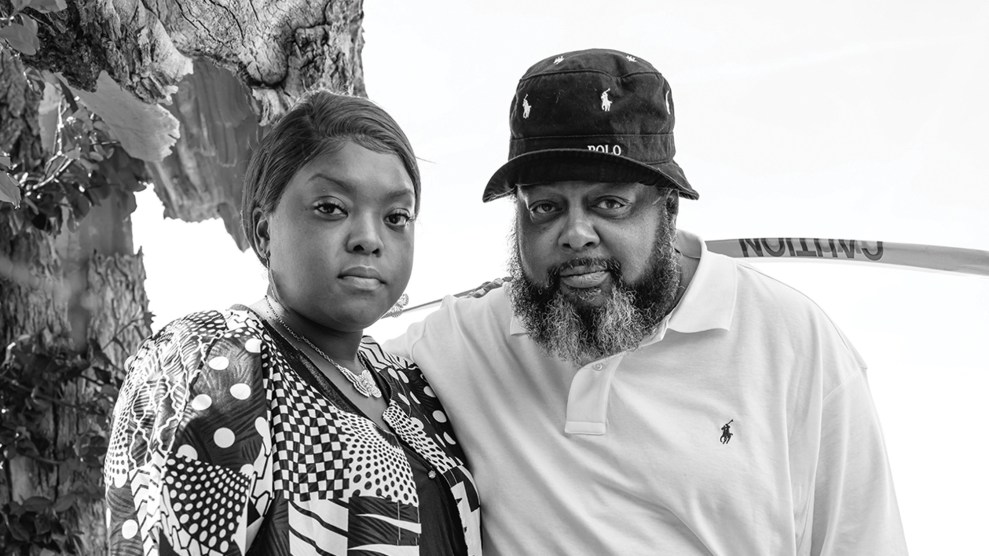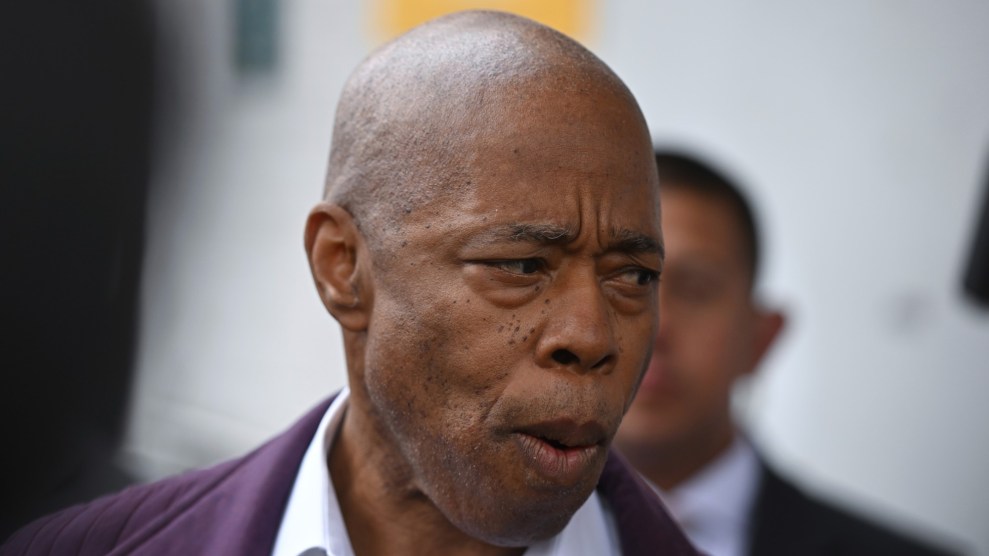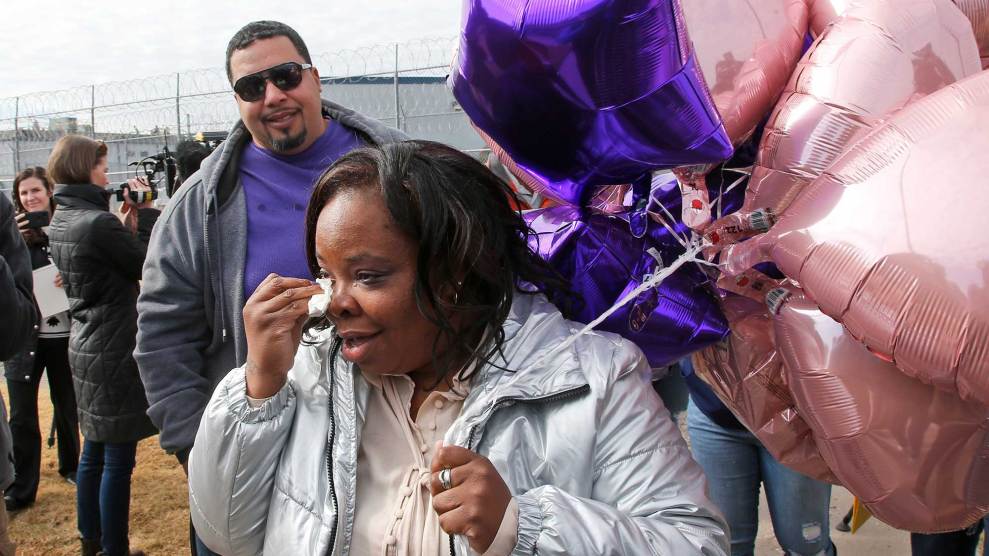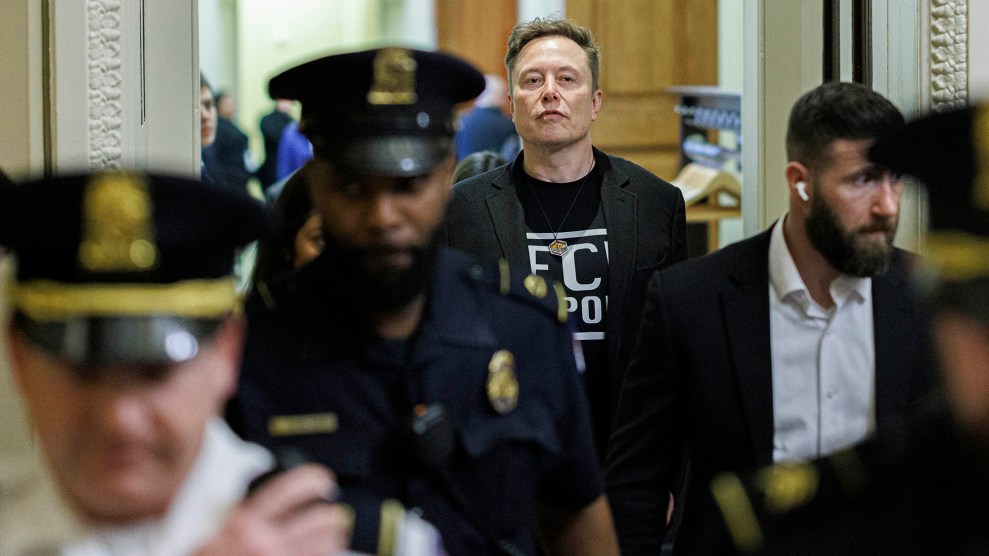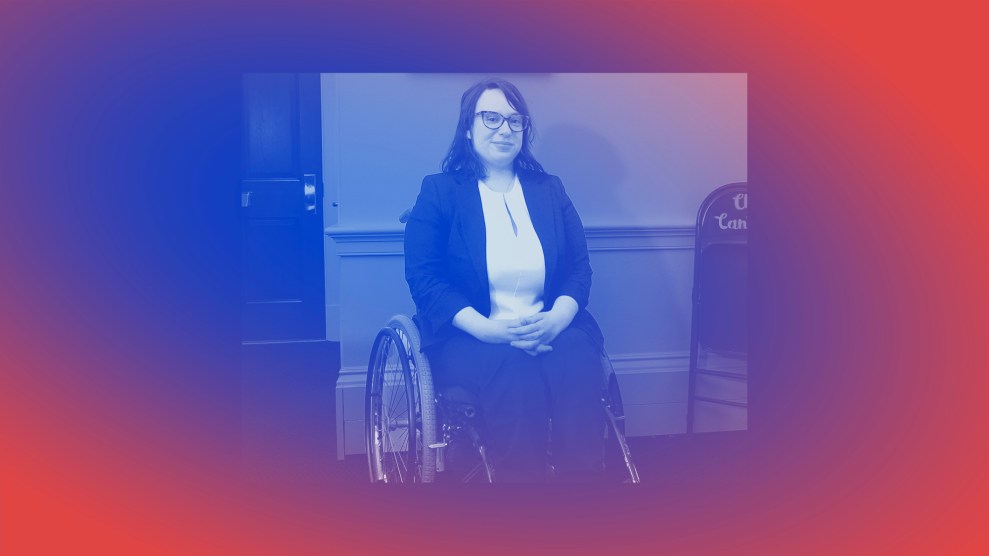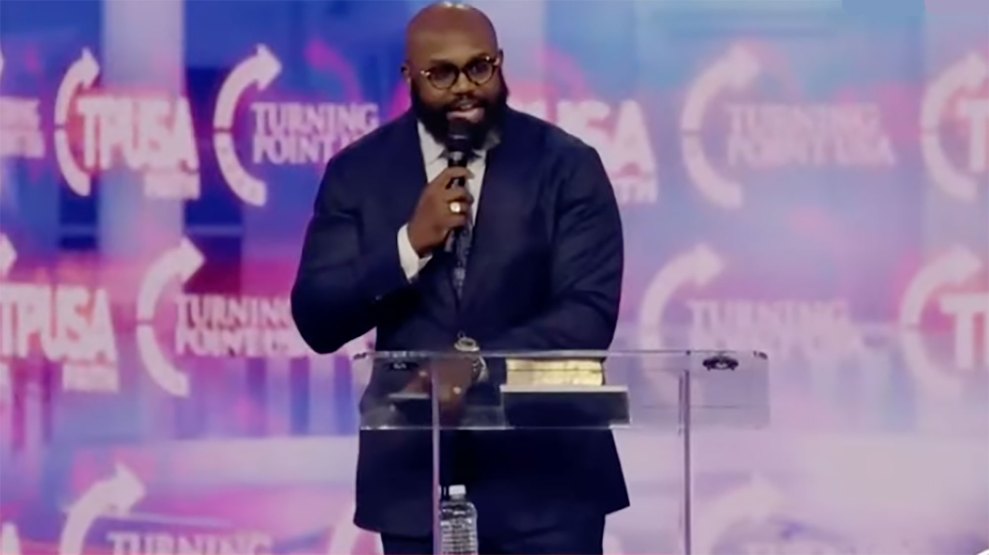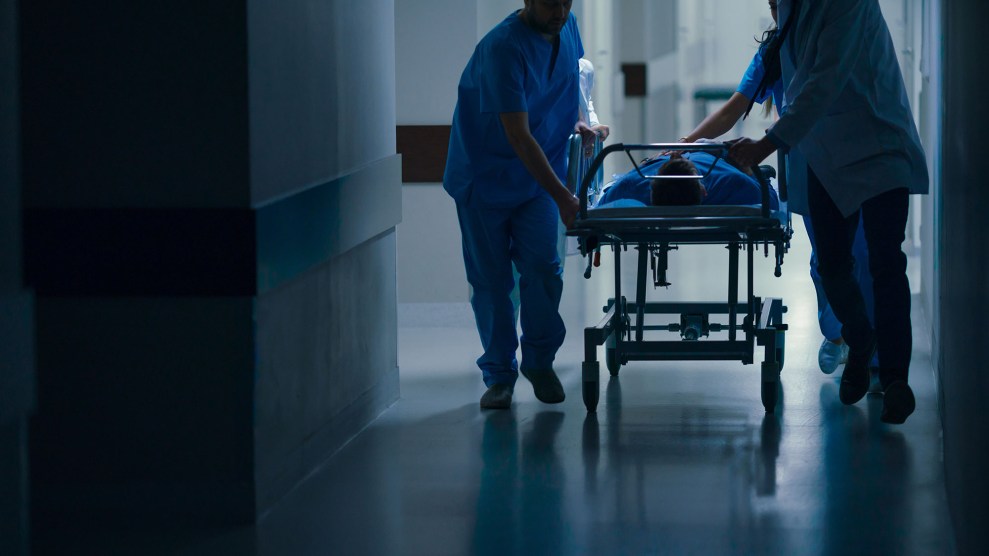
gorodenkoff/Getty
This story was originally published by ProPublica, a Pulitzer Prize-winning investigative newsroom, in partnership with NJ Advance Media and WNYC. Sign up for The Big Story newsletter to receive stories like this one in your inbox.
On a Thursday morning this past April, 61-year-old Darryl Young was lying unconscious in the eighth-floor intensive care unit of Newark Beth Israel Medical Center. After suffering from congestive heart failure for years, Young, a Navy veteran and former truck driver with three children, had received a heart transplant on Sept. 21, 2018. He didn’t wake up after the operation and had been in a vegetative state ever since.
Machines whirred in his room, pumping air into his lungs. Nutrients and fluids dripped from a tube into his stomach. Young had always been fastidious, but now his hair and toenails had grown long. A nurse suctioned mucus from his throat several times a day to keep him from choking, according to employees familiar with his care. His medical record would note: “He follows no commands. He looks very encephalopathic”—brain damaged.
That day, in another wing of the hospital, where a group of surgeons, cardiologists, transplant coordinators, nurses, and social workers gathered for their weekly meeting in a second-floor conference room, his name came up.
“Anything on Darryl Young?” asked cardiologist Dr. Darko Vucicevic, according to a recording of the meeting obtained by ProPublica.
“Need to keep him alive till June 30 at a minimum,” responded Dr. Mark Zucker, director of the hospital’s heart and lung transplant programs.
Since the transplant, Young had suffered from pneumonia, strokes, seizures, and a fungal infection. The Newark transplant team believed that he would never wake up or recover function, according to current and former staff members familiar with his case, as well as audio recordings. Yet they wanted to do all they could to keep his new heart beating.
The recordings show that the transplant team was fixated on keeping him alive, rather than his quality of life or his family’s wishes, because of worries about the transplant program’s survival rate, the proportion of people undergoing transplants who are still alive a year after their operations. Federal regulators rely on this statistic to evaluate — and sometimes penalize — transplant programs, giving hospitals across the country a reputational and financial incentive to game it. Newark Beth Israel’s one-year survival rate for heart transplants had dipped, and if Young were to die too soon, the program’s standing and even its own survival might be in jeopardy.
June 30, Zucker explained at the meeting, was the date of the next report by a federally funded organization that tracks transplant survival rates. “If he’s not dead in this report, even if he’s dead in the next report, it becomes an issue that moves out six more months,” he said in the recording.
Zucker cautioned the staff against offering Young’s family the option of switching from aggressive treatment to palliative care, which focuses on comfort, until September, which would mark one year since his transplant. “This is very disingenuous, right? It’s very unethical.”
Dr. Martin Strueber, a transplant surgeon who has since left the hospital, then expressed hope that the transplant team could “move the program forward … to a status that we never ever have this discussion again,” or even have to “think about this ethical dilemma of keeping somebody alive for the sake of the program.”
Dr. Navin Rajagopalan, the heart program’s medical director, wanted to make sure the family hadn’t already requested palliative treatment. “They’ve not asked…for us to withdraw care?” he asked. “I’m playing devil’s advocate” he went on. “It’s not as if they’re asking for this and we’re saying no, we cannot do this.”
Zucker replied, “We haven’t refused anything they’ve asked.” He added, “We just haven’t raised withdrawing it.”
In the ensuing months, the doctors continued to leave Young’s family in the dark, according to his sister Andrea and employees familiar with Young’s care. They didn’t want to run any risk that the people who loved him would interfere with their agenda: boosting the program’s numbers. “I’m not sure that this is ethical, moral or right,” Zucker told the team at the April meeting, but it’s “for the global good of the future transplant recipients.”
In 2007, the U.S. Centers for Medicare and Medicaid Services, which tracks outcomes of all organ transplants, set quality standards after a number of high profile mishaps at other hospitals, including a teenage girl receiving a heart and lung with the wrong blood type. Under those rules, the one-year survival rate has been “the magic number,” according to Laura Aguiar, principal of consulting firm Transplant Solutions.
If a program’s survival rate fell too far under its expected rate, which was calculated by a CMS algorithm, the agency could launch an audit. If the audit uncovered serious problems, CMS could pull a program’s Medicare certification, meaning that the federal health care insurer would stop reimbursing for transplants. This penalty can be “devastating,” Aguiar said, because many commercial insurers and some state Medicaid plans only pay for procedures at Medicare-approved programs. Hospitals charge about $1.4 million for a heart transplant, consulting firm Milliman reported in 2017.
In the past decade, more than 20 transplant programs lost Medicare funding after CMS found deficiencies; most shut down, according to the agency. An additional 40 reached a Systems Improvement Agreement with CMS, allowing them to continue receiving federal funding while getting back into compliance with the agency’s requirements. In 2008, Johns Hopkins’ liver transplant program entered into such an agreement with CMS because of lower-than-expected performance outcomes. More recently, CMS cut off funding to Baylor St. Luke’s Medical Center’s heart transplant program, following an investigation by ProPublica and the Houston Chronicle revealing a high rate of patient deaths. The hospital initially appealed but then opted instead to reapply at a later date.
To bolster their survival rates, some transplant centers have turned down patients who were considered too sick or rejected organs that were deemed imperfect. Critics have said that this conservative approach can deprive patients of the chance to receive lifesaving treatment and waste potentially usable organs at a time when the demand for them far outpaces the supply.
Newark Beth Israel shows another facet of how transplant providers can game the system, a ProPublica investigation found. Worried that the transplant program’s existence was threatened by a downturn in its survival rate, doctors appeared to tailor medical decisions to the metrics for at least four patients, and they sometimes didn’t consult adequately with patients and family members.
This story is based on medical records, emails, and text messages, and interviews with family members as well as eight current and former staff at Newark Beth Israel, who spoke on the condition of anonymity for fear of jeopardizing their jobs or future employment in the field. The recordings were corroborated by staff members who were present during those discussions and verified the identities of the speakers.
Newark Beth Israel said in a statement that, in response to the concerns raised by ProPublica, it is “conducting an evaluation and review of the program, its processes, and its leadership.” In an apparent reference to the recordings, it said that “disclosures of select portions of lengthy and highly complex medical discussions, when taken out of context, may distort the intent of conversations.” The hospital also said that its transplant program “has saved countless lives” and consistently met or exceeded all regulatory guidelines to maintain funding and certification, including providing one-year survival rates.
The hospital didn’t respond to questions about Young, even though his family signed a release allowing Newark Beth Israel to discuss details of his care. A spokeswoman said its statement was made on behalf of Zucker and other transplant team members, as well as hospital administrators. Strueber declined to comment separately, saying he “was not directly involved in the care of Mr. Darryl Young nor in the interactions with his family.”
The hospital also emphasized its commitment to being transparent with patients and their families. “Our patients are our utmost priority and communication with our patients and their families is paramount in enabling our team to provide the best and most comprehensive care,” it said.
In Darryl Young’s case, though, the staff’s reluctance to discuss treatment options with his family appears to run counter to the American Medical Association’s code of ethics, which encourages physicians to communicate “routinely” with patients about their care goals. When a patient is not able to communicate, the physician “has an ethical responsibility to candidly and compassionately discuss these issues with the patient’s authorized surrogate and document the surrogate’s decision in the medical record.” Withdrawing life-sustaining treatment is ethically acceptable, the AMA adds. “When an intervention no longer helps to achieve the patient’s goals for care or desired quality of life, it is ethically appropriate for physicians to withdraw it.”
After listening to the recordings, Young’s daughter, Taccara Beale, was furious. “How dare you take it upon yourself to withhold such information from any family?” Beale said. “They took a decision away from us.”
Arthur Caplan, head of the Division of Medical Ethics at NYU School of Medicine, reviewed transcripts of the recordings, including discussions about Young. “The management of this patient is egregiously unethical,” he said. “Prolonging ‘dying’ to preserve a flawed transplant program makes a mockery of transplant medicine and is an assault on both ethics and compassion.”
Founded in 1901, Newark Beth Israel has 665 beds and prides itself on its heart and lung transplant program. RWJBarnabas Health, a hospital network with which Newark Beth Israel is affiliated, counts it among “the best heart transplant hospitals that patients can trust.” A large banner on the hospital’s brown brick facade proclaims, “1,000 hearts transplanted. Countless lives touched.” One of the top 20 programs in the country by volume, it has performed 1,090 heart transplants to date, according to the hospital.
Another banner declares that Newark Beth Israel has New Jersey’s only lung transplant program. The hospital transplants far fewer lungs than hearts; 16 lungs in 2017 and 15 in 2018, compared with 49 hearts in 2017 and 38 in 2018. The lung program shut down temporarily in 2013 because of a lack of staff. For most of 2019, it has had only one lung surgeon.
Zucker has been the director of the heart transplant program for 30 years. His team currently includes five cardiologists and a surgeon, according to the hospital’s website, plus nurses, transplant coordinators, social workers, dieticians, and a pharmacist. Dr. Margarita Camacho, the surgeon who performs the vast majority of heart transplants, including Young’s, has been at the hospital since 2005. She’s well known for her practice of retrieving donor hearts in person: traveling to the donor’s hospital, inspecting the heart and bringing it back for surgery. A donated organ should be used within four to six hours of removal, so once a heart becomes available, it needs to be flown to the recipient’s hospital and rushed to the operating room. In a 2013 video posted online by Newark Beth Israel, Camacho boards a plane and says, “I’m very well suited for this job, because I love it, I really do love what I do — I’m very fortunate, but I also can survive on cat naps.”
A heart transplant is a complex and difficult operation. Surgery can last eight hours. Afterward, patients must take medication for the rest of their lives in order to prevent their immune system from rejecting the new heart.
Nonetheless, most transplants are successful, at least by the government’s one-year metric. The national probability of surviving for a year for heart patients transplanted between January 2016 through June 2018 was 91.5%, according to the Scientific Registry of Transplant Recipients, which is funded by the U.S. Department of Health and Human Services to track and analyze transplant outcomes. (SRTR publishes the semiannual reports that Zucker referred to when he said that Young needed to be kept alive until at least June 30.)
From 2008 through 2017, Newark Beth Israel’s annual one-year survival rate for patients receiving a heart transplant has never dipped below 85.7 percent, rising as high as 96.9 percent in 2012, according to SRTR. But its performance declined in 2018 for reasons that remain unclear. Of 38 patients who received a heart transplant, six have already died within a year of their surgery, according to current and former staff. The causes ranged from complications after severe oxygen deprivation to the brain to a parasitic infection.
The six deaths translated into an 84.2 percent survival rate. If Young were to be the seventh, the rate would slip further, to 81.6 percent, well below the national average—and unlikely, the transplant team worried, to escape the federal government’s attention.
For nearly a year now, Andrea Young has commuted an hour each way from Trenton every week to sit by her older brother’s bedside, holding his hand and praying for his recovery. She is also Darryl’s health care proxy; he had designated her to make decisions about his treatment, in the event that he was unable to do so himself.
Andrea, who is 59, retired at 55 from a decadeslong position as an analyst at the New Jersey Motor Vehicle Commission. She and Darryl had always been close. He joined the Navy at the age of 18 and served four years on the USS Kitty Hawk, naval records show. After spending time on opposite coasts, both siblings returned to New Jersey, where their mother’s family lived, to settle down. They both loved keeping up with the news, sometimes calling each other as late as 11 p.m. to discuss a breaking story on cable TV.
“We talked every day,” she said. “We’d call sometimes two times, even four times in a day. Now I feel a big void.”
After a heart attack, Young received a mechanical pump, known as a left ventricular assist device, or LVAD, in 2014, according to his sister and medical records. The implanted device is often used as a bridge to transplant, helping to keep a patient’s heart going while waiting for an organ match. The LVAD comes with a control unit, and batteries are worn in a holster. Showers are awkward because the equipment must stay dry.
Young was always impeccably dressed, wearing a suit to medical appointments. He spent so much time chatting with the nursing staff that the meetings would often run over, according to employees. He never complained, his sister said. He loved life and was hopeful that a heart transplant would help him continue to enjoy it.
After about three years on the waitlist, Young received a call from Newark Beth Israel late at night on Sept. 20, 2018, Andrea recalled. A heart was available. He was told to arrive at the hospital as soon as possible and went into surgery the following day. At Newark Beth Israel, surgery candidates aren’t required to spell out their wishes for care in the event of being incapacitated, and Young didn’t.
Initially, his family was told that the operation had gone well, and there was no reason to worry, his sister said. A few days after the transplant, Andrea Young spoke with Camacho on the phone and asked why her brother hadn’t woken up yet. Camacho reassured her, saying she’d seen many patients in similar situations make “a full recovery,” Andrea recalled.
As days turned into weeks, she became increasingly concerned. “I didn’t have a good feeling,” she said. “None of the doctors were very forthcoming. I felt like they were hiding something.”
About three weeks after the surgery, Andrea Young said, she requested a meeting with her brother’s medical team. But first, she went to her local library and checked out some neurology textbooks. Although her hands were full with two children she had adopted—brothers who were 5 and 6 years old—she made time to pore over the textbooks, trying to prepare so she could ask the correct questions. “I studied them for six hours, trying to understand,” she said.
At the meeting, she asked if the surgeon had seen any sign that her brother’s brain was deprived of oxygen during the surgery. Camacho said no, Young recalled. It was another cardiologist, whose name Andrea can’t recall, who told her around this time that Young’s MRI showed brain damage.
“I asked, Which part of the brain? And he said, ‘Every part, but just a very small part of each section,’ and that gave me hope. Now I know it was false hope.”
Typically, if a patient suffers brain damage in an operation and doesn’t wake up, doctors are supposed to meet with the family to explain the prognosis and options for care. “You’d explain in a direct and empathetic way that it’s not likely that this person will recover in a clinically meaningful way and then the question you’d hone in on is, ‘If your loved one were awake to hear this, what would he or she want?’” said Dr. Ali Zarrabi, assistant professor of medicine and palliative care physician at Emory University School of Medicine. The options presented would range from hospice care—which typically entails removing machine support, such as a ventilator, and not administering antibiotics for an infection—to a do not resuscitate order in case of cardiac arrest, to life-sustaining therapy. But even though a few staff members suggested that the team schedule a meeting for Young’s family to discuss options for his care, including hospice, the medical staff didn’t have this conversation with Young’s family, according to Andrea and employees familiar with his care.
Doctors also didn’t inform Andrea when her brother contracted C. auris, a dangerous fungal infection that the U.S. Centers for Disease Control and Prevention says is a “serious global health threat” because it is difficult to identify and is often resistant to multiple drugs.
According to text messages reviewed by ProPublica, Darryl Young had been treated for the infection at least once by early March. But Andrea said she only learned about it when a social worker mentioned it to her in late May. She searched on Google for information about the fungus.
“I had to ask for every meeting,” Andrea said. “I had to dig and dig and dig. I was on my own trying to do the technical research.”
Several nurses as well as a social worker were remarkably compassionate and caring toward her brother, Andrea said. Still, she struggled to get basic cosmetic care for him, she said. It grieved her to see his physical appearance neglected, with his toenails overgrown. She said she requested that the medical staff trim his nails, but it took four months before someone finally tended to them.
Leaders of the transplant program saw no alternative to keeping Young alive, employees said. Camacho, the heart surgeon, has more than once told staff that Young needs to “take one for the team,” according to two people with direct knowledge of these remarks.
At a meeting in May, Zucker articulated the trade-off. “This is a very, very unethical, immoral but unfortunately very practical solution, because the reality here is that you haven’t saved anybody if your program gets shut down,” he said, according to an audio recording obtained by ProPublica. Young “unfortunately became the seventh potential death in a very bad year, all right, and that puts us into a very difficult spot,” Zucker said.
If Young died too soon, he continued, CMS might force the program to enter a Systems Improvement Agreement. “You haven’t saved anybody if you spend $2 million in an SIA trying to defend your program, bringing outside reviewers in for two years to supervise every single transplant you do.”
According to Aguiar, the transplant consultant, $2 million is actually a low estimate of what an SIA would cost a hospital. “Usually transplants are the treatment of last resort, and you have patients referred as they’re approaching end-stage organ failure, so if there’s no more transplant program there, referrals can dry up,” causing a hospital to lose business beyond the direct expense of an SIA, she said.
For several months, administrators at a weekly hospital-wide meeting known as the “Bed Board” kept asking the transplant team why Young was occupying a hospital bed, rather than being sent to a long-term care facility, according to the recordings. Hospitals typically prefer short stays because they need beds for other patients and can start losing compensation if insurance runs out or the insurer thinks the patient should be released or transferred.
Care in an ICU unit typically costs more than $3,000 a day, according to a 2005 study of U.S. hospitals’ billing data, and about $1,000 more when the patient is on a ventilator. (Young is supported by a ventilator overnight.) He is covered by Medicare and Medicaid, but Newark Beth Israel doesn’t bill insurers until a patient is discharged. So, for the time being, the hospital was absorbing the cost of Young’s stay.
As the hospital’s chief operating officer, Douglas Zehner ran the “Bed Board” meetings. At a July transplant team meeting, Zucker said that Zehner approved the plan to keep Young in the hospital, according to an audio recording obtained by ProPublica.
Zucker said Zehner called him one night and said, “We, as an administration, have made a decision … to house this man indefinitely so that he doesn’t become a mortality,” according to the recording. Zehner was promoted July 30 to regional chief financial officer for RWJBarnabas Health.
No matter how much treatment Young received, his prospects for long-term survival in a vegetative state were dim. Patients like him can be sustained by ventilators and feeding tubes but are likely to die within a couple of years, said Dr. Randi Huo, a palliative care physician at the Everett Clinic in Everett, Washington.
“You’re looking at recurrent infection—he’s fed through a tube, he could get bed sores, he has an opening in his throat, which means he’s at risk of pneumonia,” she said. “Eventually, organisms will become resistant enough that nothing works. Then he would become septic and die.”
Even if Young isn’t in pain or distress, Huo said, his loved ones should decide the course of his care. “If the care he’s receiving is not appropriate to the life he wants to live—if medicine is not serving him, then why are [they] doing this?”
The one-year survival rate has dictated Newark Beth Israel’s treatment of other patients besides Young, according to employees and the recordings.
“A lot of you weren’t here for our first lung transplant when we reopened, after we reopened the program. The first lung transplant stayed at the hospital until day 366, was sent out to rehab and died that day,” Camacho said at the May meeting, according to a recording obtained by ProPublica.
The month before, Zucker had a similar recollection:“We did the same thing once with a lung transplant patient and this was just critical, remember? Keep that lady alive?”
It isn’t clear if Camacho and Zucker were talking about the same patient. One former employee recalled a lung transplant patient who stayed for exactly a year. “It was done on purpose and they wouldn’t let her be discharged out,” the ex-employee said.
Even for transplant patients whose conditions were not as critical as Young’s, the one-year date has been a consideration. Yosry Awad went to Newark Beth Israel on May 13 for a routine biopsy of his new heart, according to a medical record. His one-year anniversary was coming up in two weeks, on May 27.
During his hospital visit, the checkup revealed that a measure of the pressure of the blood in the heart, called filling pressure, was high, according to staff familiar with his care. The medical team decided to admit Awad and treat him with diuretics, which can help reduce blood pressure.
Awad had suffered multiple serious complications after his transplant surgery the previous year, including a cardiac arrest that required his heart to be temporarily supported by a machine that performs the functions of the heart and lungs, according to medical records. Given his history of complications, Newark’s staff was anxious to make sure he would reach his one-year date, according to three people familiar with Awad’s case.
A week and a half later, Awad was still at Newark Beth Israel. By that point, there was no medical reason requiring that he stay in the hospital, according to the three people. But the medical team delayed his discharge.
A medical record viewed by ProPublica stated that Awad “remains in very good spirits and is hopeful to go home prior to the holiday weekend. Per the medical team he will remain hospitalized through 5/27 to hit his one year anniversary.”
After the weekend, the transplant team joked about Awad. “Well today is his one year, so congratulations!” said cardiologist Vucicevic. “Discharge!” chimed in medical director Rajagopalan, according to an audio recording and employees who witnessed the conversation.
In an interview at his home, Awad acknowledged that he had wanted to go home in May and spend Memorial Day weekend with his family. As far as he knew, he said, the hospital kept him because of his blood pressure problems. He added that he is grateful for the heart he received at Beth Israel. “I know I’m lucky,” he said.
“We are not doctors or nurses, how would we know” whether his stay was justified, asked his sister and caregiver, Nagwa Helmy, who said she was satisfied with the hospital’s care of her brother. Although Awad signed a release allowing the hospital to discuss his care, it did not respond to questions about him.
Another patient, who received both a heart and kidney transplant, similarly had a hospital stay extended until his one-year anniversary, according to two staff members familiar with his care. The patient’s family did not respond to requests for comment. Medical records reviewed by ProPublica show he was admitted at the end of last January with abdominal pain. About three weeks before the anniversary, Zucker instructed staff to “keep him alive,” one employee recalled. When he reached the milestone on a Thursday in late March, the record noted, “1 year anniversary.”
He was discharged the following Monday.
It wasn’t until late July, 10 months after Young’s surgery, that anyone at Newark Beth Israel consulted his sister about his future care.
Andrea Young recalled that she was leaving the hospital, already late to pick up her sons from school, when cardiologist Dr. Laurie Letarte asked her permission to do a procedure to see if the fungal infection had spread to Darryl Young’s heart.
Letarte asked “what I would like to have done for my brother with respect to his treatment,” Young recalled. Letarte, though, didn’t go into detail about her brother’s prognosis or options such as a do not resuscitate order.
Taken aback, Andrea said she responded, “I’m not making any absolute decisions.” She said she asked Letarte to continue standard care for her brother for now. Nobody from the hospital followed up on the 10-minute conversation, Andrea said.
A few weeks later, sitting in her living room while her two boys zoomed up and down the stairs, bouncing onto the couch for a hug then running off to grab toys, Andrea mused about her desires for Darryl.
Wrestling with the pressure of making the correct decisions for her brother, she said she wasn’t sure about hospice care, if it meant removing Young’s ventilator. “I’m not ready to make that kind of decision,” she said, adding that other family members might want to visit him first.
But she was contemplating a DNR order. “Why resuscitate someone who loved life so much?” she wondered.
After listening to the audio recordings of the transplant team’s meetings, she shook her head. “I know that what happened could’ve not been intentional, but at the very least, they could be honest,” she said. “People should be able to make informed decisions for themselves and their loved one.”
She wondered if her brother could possibly be brought home to his own apartment someday.
“I want him to have the wind in his hair and the sun on his face,” she said. “I want him to be as comfortable as he can.”
On a Tuesday at the end of August, I accompanied Andrea on her weekly visit to her brother. On the eighth floor, we had to stop outside his room to put on gowns and gloves — precautions against an infection that could kill him.
Darryl Young’s eyes were open, drifting over the ceiling. They did not connect with Andrea as she leaned over the bed, greeting him.
“Hi Darryl, how are you today?”
Young’s corner room overlooked the street. It was bare of any personal effects — no photographs or cards to give a clue about the man who had been in the hospital for nearly a year. Instead, he was surrounded by machines. On the right of the bed was a monitor to track his vital signs. On the left was the ventilator used at night to help him breathe, and hanging near him, a bottle of nutrients and a bag of liquid for hydration. Every inhalation was accompanied by a gurgling noise, perhaps caused by mucus in his tracheostomy tube. The only other sound in the room came from the TV over the bed, set on CNN, which was warning of a hurricane approaching Puerto Rico.
Young asked a passing nurse if the doctors were around, and she was told that Zucker and Letarte weren’t on the floor. She asked if anyone could tell her how her brother’s most recent procedure had gone. The hospital staff had told her that they would drain his lungs because he had a bout of pneumonia, and she had asked if someone could call her afterward and update her, but nobody had. The nurse said he didn’t know.
Young turned back to her brother. She pulled up a song on her phone: “Lean on Me,” which had been their mother’s favorite tune.
She held her phone close to his ear so he could hear the lyrics: “Lean on me, when you’re not strong, and I’ll be your friend, I’ll help you carry on….”
With her other hand, she stroked his face and arm.
“It’s OK,” she murmured. “You can close your eyes if you’re tired, you can sleep.”
Around that time, Andrea Young sat down and wrote a short statement, expressing her feelings about her brother’s treatment.
“These revelations are deeply disturbing,” she wrote. “I will be forever grateful to those who had the courage to come forward, possibly putting themselves at risk, to expose this hospital’s wrongdoing. It is my hope that the appropriate action will be taken against the hospital as well as the doctors involved for such a betrayal of trust and for inflicting such pain upon me, my family, and many other families as well.”
As part of the Trump administration’s deregulatory push, it is relaxing performance requirements for transplant programs. Under a rule that was finalized last month and will take effect in November, transplant programs won’t have to submit data on outcomes to CMS to receive Medicare reimbursement. However, SRTR will continue to report one-year survival rates, and CMS says it will still monitor quality of care and investigate complaints.
Three days before the anniversary of Young’s transplant, Andrea Young was met at the hospital by a cardiologist and a social worker. They told her that Darryl was now stable enough to consider a move to a long-term care facility. The social worker offered to start looking up facilities. Andrea Young asked why, after all this time, they were planning to transfer him. She didn’t get a clear response, she said.
On Sept. 21, one year after his operation, Darryl Young was still alive, and still at Newark Beth Israel. After so long in a vegetative state, the chances of a patient regaining the ability to communicate are “grim to none,” said Dr. Joseph Safdieh, associate professor of neurology at Weill Cornell Medicine. But for the hospital, Young now counted as a victory.

